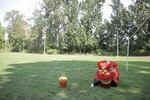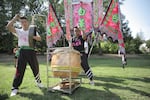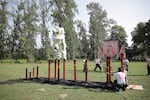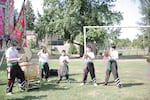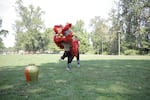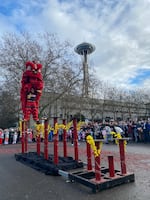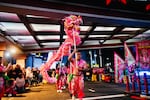On a warm September day at Willamette Park, Nhan Danh waits for his team to arrive for practice.
The team members slowly makes their way to the park dressed in their workout clothes, consisting of black pants a white T-shirt with the words “White Lotus Dragon and Lion Dance” emblazoned on the back, and masks to wear while they practice.
Danh sits beside a large truck that takes up the parking lot’s loading area. Inside are the costumes of Chinese lions, adorned with elegant fur of all different colors, ready for their performers to bring them to life.
“The basic colors of lions are red and gold,” he said. “Red lions are the most luck-given lions, so any clients that hire us, we will use our red lion as they go-to color unless they have a preference.”
Danh knows something about the art of Chinese lion dance. He’s been performing it his whole life.
“My dad got me into lion dancing since I was about five,” he said. “A lot of the Vietnamese musicals that my parents would play for me as a kid would showcase lion dancing. And it’s really it sparked something in me.”
That spark led to Danh performing as part of a Buddhist youth team in Portland. He spent years learning the craft and perfecting his skills and soon, it was time for him to branch off and create his own team.
In 2015, Danh founded White Lotus Dragon & Lion Dance.
“I started White Lotus in Portland to give out the quality of lion dancing that it’s very similar to Hong Kong, Vietnam, Malaysia. That same type of production, that same type of high energy,” he said.
When coming up with the name, Danh recalled his time as part of the Buddhist youth group that lead him to pick the name.
“In Buddhist culture, the lotus is a very purified flower,” he said. “It grows in the swamp, it is really pretty. I wanted a piece of the Buddhist youth group with me.”
White Lotus primarily performs the southern lion dance in the styles of hok san and sar ping, which mimic the lifelike movements of a cat and involve crowed interaction.
“An audience member can pet the lion. The kids aren’t running away. They’re not scared because they think it’s cute,” he said.
Two people perform the dance together: one plays as the head, and the other plays as the tail. Just like any partnership, success comes down to chemistry.
“I have members on my team are really good buds. Then they understand each other mutually, so they always trust each other,” he said.
The team is a mix of students ranging from young children to experienced adults.
During practice, Danh is tough, drilling his students on the correct techniques, and he’s even tougher when it comes to the performance routine.
“Get lower, bro!” he shouts to one youngster, before walking over and showing him how to get into the correct stance.
His toughness as an instructor ensures that the students learn the correct moves for their own safety.
“We don’t like a sloppy lion dancer. The community doesn’t like a sloppy lion dancer. So we really drill them on these forms and foundations and make sure they hit other movements and their stances right,” he said.
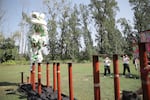
Two of White Lotus Dragon & Lion Dance's most advanced members perform on jongs, metal poles topped with a circular platform.
Kanani Cortez / OPB
That attention to safety also applies to the experienced members. Two of his most advanced members perform on jongs, a series of metal poles, each topped with a circular metal platform. The partners must have complete faith in one another if they are to do stunts on these poles safely.
“The tallest pole on a jong, is 10 feet So imagine doing ahead stack or just jumping from an 8 foot pole with a distance of 6 feet onto like a 10 foot pole. That’s a lot of trust,” he said.
Danh pays close attention to his younger members, who he hopes will learn lion dance not just as a sport, but an important part of their Asian American roots.
“Not a lot of Asian youth really carry this part of the culture,” he said. “It’s not as cool as playing basketball or football. But lion dancing. ... It’s a part of my Asian culture and my Asian heritage. And that’s just a piece that I try to hold with me for future generations like the kids of my team or my kids one day.”
It’s not lost on Danh the importance of lion dance to the Asian American community, especially around the Lunar New Year.
“It’s a lot of pressure,” he said. “When clients hire lion dancing, they want two things; they want us to bring them luck and scare away evil spirits. I always have to be mindful of that.”
The Lunar New Year is usually a time of celebration and gathering for many Asian communities.
However, this year will be very different. Due to the ongoing COVID-19 pandemic, many of Portland’s lion dance associations have had to cancel or modify performances including celebrating the new year.
“COVID definitely hit us with that nice curveball that nobody saw coming,” Danh said.
Since last March, White Lotus had to cancel almost all its shows, and what shows the dancers were able to perform were much smaller in scale and keeping with social distancing guidelines, including wearing masks.
“Usually, every Lunar New Year we perform at various Buddhist temples at midnight,” he said. “We split up into four or five teams and tackle all the midnight shows. But this year we won’t have any of that celebration.”
It’s also been a challenge to get the requisite practice time in for his team, especially for the younger members.
“The biggest challenge has been to make parents comfortable with letting their kids participate in classes and shows. We’re limited to practice times so we can only do so much in terms of prepping,” he said.
To solve that, Danh posted tutorial videos online for the members to learn and practice.
But it’s still challenging for White Lotus to arrange performances.
“Because the city is still on lockdown, it affects the team because if it’s not safe to eat in a restaurant, it’s not safe to be in gatherings and groups.”
All isn’t lost, though. This Lunar New Year, Danh and his team will perform at two venues, one in Lake Oswego and another at ilani Casino and Resort in Washington. They also recorded two virtual shows, which will be broadcast at Washington Square Mall and the Portland Art and Cultural Center.
Despite the setbacks, Danh has remained optimistic about showing support to those who have supported the team.

Because of the restrictions due to the COVID-19 pandemic, Nhan Danh and his team couldn't perform any shows. So Danh decided to be proactive and organize a food drive to give to Southeast Portland's frontline workers.
Nhan Danh / Courtesy
A few months into the shutdown, he organized a food drive for some of Portland’s essential workers.
“We met up, masks on, gloves on, and we just we gave out food to the frontline workers, just to make them feel good that, amongst everything they’re still out there bagging groceries for us and supporting the community,” he said.
With the new year comes a chance to start fresh, and for Danh to push White Lotus forward as ambassadors in the Asian American community.
“We want to be the only team that people think of when they think of lion dancing,” he said. “We’re the team that does it the most authentically, in it’s purest form, and it’s the most festive and fun.”
And perhaps more importantly, as his team finishes up practice and gathers around for one last group huddle before ending the day, Danh hopes to continue to pass along the lessons that he learned about lion dancing to the younger generation.
“Just to be able to continue that legacy and tradition to more and more youth along the road,” he said.

